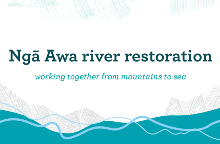Ngā Awa river restoration programme
Introduction
Taking a whole catchment approach, Ngā Awa is working in partnership with others to restore the biodiversity of 12 rivers from mountains to sea.
Ngā Awa began in 2019 and is an extension of our existing work to slow the decline in New Zealand’s biodiversity. It focuses on a diverse range of priority river catchments across the country.
Vision and objectives
We are working with communities towards healthy, thriving rivers from source to sea.
The programme's objectives are:
- river ecosystems and species are thriving from mountain to sea
- restored rivers are enriching people's lives.
The objectives are being achieved by collaborating with others, co-designing and co-leading with iwi, hapū and whānau and by recognising climate change. Planning the restoration work is underpinned by sound technical and scientific advice.
A local partnership approach
From source to coast, rivers run through many different landscapes including native vegetation, farming, horticulture, forestry and urban areas. All these activities and land uses affect a river and need to be considered in its restoration.
Local iwi, hapū and whānau are our principal partners for Ngā Awa and are involved in all aspects of the restoration. We are also working with regional councils, landowners, businesses, community groups, Fish & Game, the Ministry for the Environment and other agencies.
Programme and engagement reports
- Ngā Awa programme report for 2022/23 (PDF, 2,081K)
- Ngā Awa programme report for 2021/2022 (PDF, 2,000K)
- Ngā Awa programme report for 2020/2021 (PDF, 1,000K)
- Ngā Awa engagement report for 2020/2021 (PDF, 590K)
- Strategy overview 2022 (PDF, 3,750K)
Ngā Awa rivers
Rivers with more information
Other Ngā Awa rivers
- Waitaki River, Canterbury
- Waimatuku Stream, Southland
Research themes and reports
Several research themes have been identified as priorities for the programme. These include climate change resilience, river geomorphology, socio-economic drivers and monitoring needs.
Research to date includes the preparation of baseline reports for several catchments. You can see these on individual river pages. Ngā Awa is also building connections with research providers to answer questions about particular catchments or to integrate our research into broader programmes.
Building climate change resilience into freshwater restoration
A report for the Taiari River catchment summarises climate change projections at a subcatchment scale. It has a focus on freshwater ecosystems and includes some management responses to the impending challenges. This is the first in a series of reports related to climate change resilience.
Environmental economic assessment for Ngā Awa Northland catchments
This report evaluates the economic contribution of the river restoration to the Northland regional economy.
More about the Northland environmental economic assessment report.
Monitoring freshwater biodiversity restoration – online tool and report
An online tool is available to help monitor the effectiveness of freshwater restoration projects like the Jobs for Nature investments in Ngā Awa catchments.
It can be used if any of the following actions are included in restoration work:
- riparian fencing or planting
- fish passage remediation
- sediment trap use
- wetland restoration
- predator control.
Access the freshwater biodiversity monitoring tool.
The tool is based on a report that explains how progress toward freshwater biodiversity gains can be demonstrated in 2–5 years.
More about the Jobs For Nature biodiversity monitoring report.
Geomorphological Evaluation of Three Ngā Awa Rivers
This report outlines the desktop techniques that are available for analysing river geomorphology, particularly in relation to water movement, sediment supply and connectivity.
More about the geomorphological evaluation report.
How the rivers were chosen
Ngā Awa includes rivers from different regions in New Zealand and from the east and west coasts. The size of their catchments is varied and together they include a range of diverse ecosystems.
Rivers that are part of this programme met the following criteria:
- the headwaters were in a natural condition
- sections of the catchment nearer the coast (lowland areas) were in good condition
- important ecosystems were present
- local communities were interested in or already involved in restoration work
- the catchment had some factors that could be fixed or improved
- there was a connection to different types of habitat on public conservation land
- some threatened fish species were present.
Contact
If you have any questions or want to get involved, email us.
Email: info@doc.govt.nz
